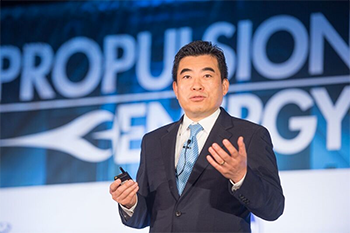Convergence of Existing Technologies Propelling New Era of Aviation Written 11 July 2017
Speaker: Rafael A. Garcia, director, Propulsion Directorate, Air Force Materiel Command
By Lawrence Garrett, AIAA Web Editor

The convergence of existing and rapidly advancing technologies has set the stage for a 21st century industrial revolution and a new era in aviation, said Jaiwon Shin, associate administrator for NASA’s Aeronautics Research Mission Directorate.
During the “New Era of Aviation” session July 11 at the 2017 AIAA Propulsion and Energy Forum in Atlanta, Shin noted the 20th century was host to three industrial revolutions: steam power and electrical power; the division of labor and mass production; and the digital revolution. He said all brought and continue to bring tremendous societal benefits.
The major difference with 21st century innovation, Shin said, is that many of the disruptive innovations today are not the result of one leading technology but rather the result of the convergence of existing, disparate technologies. One such example is drones.
“If you look at [drones], there was no new invention,” Shin said. “All of those technologies existed before drones came to the world, so that’s the very big distinction and unique characteristic in the 21st century innovation.”
Shin cited the smartphone as another example of 21st century innovation.
“Some smart people started pulling these disparate technologies together, and voila, you have a smartphone,” he said.
Shin said it’s important for members of the aviation industry to really start thinking about this concept of the convergence of technologies, noting that although the aviation industry has always served as “the pinnacle of modern engineering and science,” it could benefit by capitalizing on what other industries are doing.
Tesla is one example of a 21st century innovative company, Shin said, because it works in multiple sectors and has a clear mission involving sustainable energy. Shin said that in looking to the future, innovative organizations will succeed not necessarily with products but, like Tesla, with a clear mission and core technology.
Manufacturing is also important, Shin said, especially with the emergence of artificial intelligence and automation and the potential impact of those innovations.
“A lot of people are talking about AI and robots and so on,” he said. “Well, who’s going to make robots, and who’s going to make chips going into all that?”
Shin maintained that sustainable and profitable innovation requires manufacturing, adding that additive manufacturing is going to make it that much easier to manufacture a multitude of designs.
Ultimately, the convergence of technologies and learning from different industries is critically important, he said.
“There is enough innovation using convergence of technologies, and that’s what I’m presenting that we should in the aviation industry as well — not just dwelling in what we have and holding onto what we have, but building upon what we have and moving into the next phase of aviation,” Shin said.
But, he cautioned, the industry needs to be leading the charge.
“The aviation industry needs to be in the driver’s seat to open up this possibility,” Shin said. “We don’t want to be in the passenger seat, or worse yet, in the backseat, and watching IT-based companies opening up this world. Our industry should be leading the pack to bring this revolution in aviation.”
